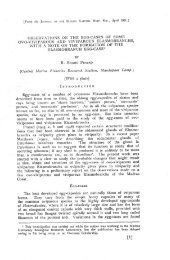PDF - Eprints@CMFRI
PDF - Eprints@CMFRI
PDF - Eprints@CMFRI
You also want an ePaper? Increase the reach of your titles
YUMPU automatically turns print PDFs into web optimized ePapers that Google loves.
56<br />
S 8398 is only pan of a colony. It is a fused mass of branches in the form of an inverted cone,<br />
almost similar to BERNARD 's M. edwardsi. The sides of the cone are mostly smooth. The papillae are<br />
very conspicuous at the top of the cone, between them minute calices (OJ to 0.5 mm) are seen.<br />
Material:<br />
Gulf of Suez: T . Aviv NS 8398 , 8399,8405 (Ras Matarma); 8462 (EI Bilaiyim); 8198 (Ras el<br />
Kanisa).<br />
Gulf of Aqaba: Jerus. SLR 379 (Marsa Murach).<br />
T. Aviv NS 1351,6343 (Eilat) ; 1934 (Marsa Murach).<br />
Northern R. 5. : USNM Wa 105 (Ghardaqa).<br />
HLM EC 422 ( Koseir); 246,247 (without exact locality).<br />
Southern R. S.: HLM X2 : 13 - 2, 3, 4 (Sarso Isl.).<br />
EC 356 , 357 , 359 (Massawa).<br />
Without local. : HLM EC 167 (Red Sea).<br />
Dis t rib uti 0 n: Red Sea; Philippines.<br />
Rem ark s: The following species with arborescent or tufted corallum and papillae are known from<br />
Red Sea: M. abrotanoides, M. circumva//ata (EHRENBERG 's type in Berlin Museum is No. 931), M. crista<br />
galli, M. densa , M. edwardsi, M. graci/is, M. nudiceps and M. spongiosa. Among these M. spongiosa has<br />
large corallites that are wide apart with foveolare coenenchyme along with papillae. The affinity of M.<br />
spongiosa as far as the calicular derails are concerned is more with M. meandrina. In fact some of the<br />
specimens which we place under M. meandrina could form a link between M. spongiosa and meandrina.<br />
Only further observations in the field will settle their status. M. abrotanoides (= M. nudiceps DANA) is a<br />
little known species. BERNARD'S description is positively fitting with some of our specimens described<br />
here, and we take this as the same as M. circumvallata. MARENZELLER (1906) has already merged M.<br />
crista galli with M. circumva//ata. We put also with some doubts MARENZELLER 'S M. densa (No . 4486 in<br />
Berlin Museum) to rhe present species. We have described two specimens under the name graci/is maintaining<br />
the distinction pointed out by KLUNZINGER . However, it is likely that M. graci/is should fall<br />
within the skeletal range of M. circumvallata. Vet another species that merits consideration here is<br />
M. edwardsi BERNARD. Though we have recognized it here as valid species, its status is not beyond doubt.<br />
M. edwardsi could be an extreme fo rm of growth of M. circumva//ata. The squeezing out of the papillae<br />
at t he top of rhe fused cones in M. edwardsi, which BERNARD stresses very much, can be d ue to the<br />
fusion of the growing edges of the branches, whereas the papillae are better developed in M. circumval/ata<br />
.<br />
NEMENZO (1967 ) described so me new species closely related to M. circumvallata from the Philippine<br />
waters, such as M. coa/ita, M. hirsuta, M. inconstans, M. ma/ampaya and M. strigosa. The differences among<br />
themselves appear to be only mere skeletal variations which should be expected in two different coralla<br />
of the same species. We think aU the above mentioned species of NEMENZO are only variations of o ne<br />
species which is the same as M. circumvallata , rhough we have not studied any of his type specimens.<br />
C. Tuberculate species of Montipora.<br />
Porites<br />
Marlopom<br />
Monripora<br />
stiJOSD<br />
Sli/oSQ<br />
stiloSD<br />
Montipora sti/osa (EHRENBERG). 1834<br />
(Plate 11, Figs.. 3- 7)<br />
1834. EHRENBERG, 142 (Type lOCality: Red Sea).<br />
1846. DANA. 500.<br />
1860. MIl.'IE EDWARDS (& HAIME). 21t.<br />
1879. KLUNZINGER 2. lO , pi,. 517 , 615 , 10/1.<br />
1888. OR TMANN. 156.<br />
1897. BERNARD. 115.<br />
1974, MERGN ER & SC HUHMACHER, 265.<br />
1980. HEAD. 149 , 447.<br />
The type of this species is No . 95 1 in Berlin Museum. EC 59 in HLM is from Koseir, one of KLUN<br />
ZI GER'S duplicates labelled M. sty/osa. It is an encrustation. EC 292 is abou 18 cm in greater spread.<br />
The surface rises into hillocks or gibbosities. SLR 648 is a multi-layered encrustation.
















